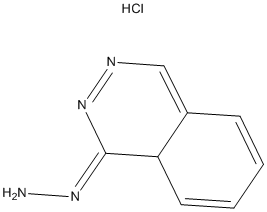All AbMole products are for research use only, cannot be used for human consumption.

Hydralazine hydrochloride is a hydrochloride salt of hydralazine (Apresoline) that is a direct-acting smooth muscle relaxant with an IC50 of 1.9 mM. Hydralazine (Apresoline) is used to treat high blood pressure. Hydralazine hydrochloride works by relaxing the blood vessels so that blood can flow more easily through the body. Hydralazine hydrochloride increases guanosine monophosphate levels, decreasing the action of the second messenger IP3, limiting calcium release from the sarcoplasmic reticulum of smooth muscle. This results in vessel relaxation. Hydralazine hydrochloride dilates arterioles more than veins. Hydralazine hydrochloride recently has been identified as a nitric oxide donor. Activation of hypoxia-inducible factors has been suggested as a mechanism. Hydralazine hydrochloride relaxes vascular smooth muscles of arteries and arterioles, causing peripheral vasodilation and decreasing peripheral vascular resistance. These actions decrease blood pressure and increase heart rate, stroke volume, and cardiac output.
| Molecular Weight | 196.64 |
| Formula | C8H8N4.HCl |
| CAS Number | 304-20-1 |
| Form | Solid |
| Solubility (25°C) | DMSO |
| Storage |
Powder -20°C 3 years ; 4°C 2 years In solvent -80°C 6 months ; -20°C 1 month |
[2] Kimberly S Collins, et al. Genotype-Guided Hydralazine Therapy
| Related HIF Products |
|---|
| HIF-1α-IN-3
HIF-1α-IN-3 is a hypoxia-selective HIF-1α inhibitor. |
| HIF-2α-IN-2
HIF-2α-IN-2 is a hypoxia-inducible factors (HIF-2α) inhibitor, has an IC50 of 16 nM in scintillation proximity assay (SPA). |
| PRLX-93936 dihydrochloride
PRLX-93936 dihydrochloride is a HIF-1α inhibitor with anticancer activity. |
| 3-Aminobenzoic acid
3-Aminobenzoic acid is a hypoxia-inducible factor-1α (HIF-1α) inhibitor. |
| Steppogenin
Steppogenin is a potent inhibitor of HIF-1α and DLL4, with IC50 values of 0.56 and 8.46 μM, respectively. |
All AbMole products are for research use only, cannot be used for human consumption or veterinary use. We do not provide products or services to individuals. Please comply with the intended use and do not use AbMole products for any other purpose.


Products are for research use only. Not for human use. We do not sell to patients.
© Copyright 2010-2024 AbMole BioScience. All Rights Reserved.
